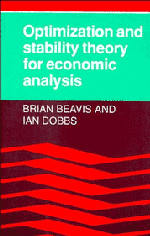Book contents
- Frontmatter
- Contents
- Preface
- 1 CONVEXITY
- 2 STATIC OPTIMIZATION
- 3 EQUILIBRIUM MATHEMATICS
- 4 COMPARATIVE STATICS AND DUALITY
- 5 DYNAMICS AND STABILITY
- 6 INTRODUCTION TO DYNAMIC OPTIMIZATION AND THE CALCULUS OF VARIATIONS
- 7 OPTIMAL CONTROL THEORY
- APPENDICES – MATHEMATICAL REVIEW
- Glossary
- Bibliography
- Author Index
- Subject Index
3 - EQUILIBRIUM MATHEMATICS
Published online by Cambridge University Press: 05 July 2011
- Frontmatter
- Contents
- Preface
- 1 CONVEXITY
- 2 STATIC OPTIMIZATION
- 3 EQUILIBRIUM MATHEMATICS
- 4 COMPARATIVE STATICS AND DUALITY
- 5 DYNAMICS AND STABILITY
- 6 INTRODUCTION TO DYNAMIC OPTIMIZATION AND THE CALCULUS OF VARIATIONS
- 7 OPTIMAL CONTROL THEORY
- APPENDICES – MATHEMATICAL REVIEW
- Glossary
- Bibliography
- Author Index
- Subject Index
Summary
INTRODUCTION
In this chapter we consider some important mathematical concepts which are frequently used to establish the existence of various types of equilibrium notion in the economics literature. A wide variety of equilibrium notions occur in the economics literature but the confines of space dictate that we consider only some of the more important notions. In Section 3.2, the essential mathematical concepts are presented. These are employed in Section 3.3 to establish the existence of a competitive equilibrium in a private ownership economy with a finite number of agents and commodities, and in Section 3.4, to establish the existence of a Nash equilibrium in n-person non-cooperative games.
EQUILIBRIUM MATHEMATICS
In most economic models the actions taken by an agent are determined by the values of those variables which constitute his economic ‘environment’. If those values uniquely determine the action to be taken by the agent then we can work with functions (point–point mappings). However, when the action to be taken by the agent is not uniquely determined, there is a set of possible actions and we need to work with correspondences (point-set mappings).
Continuity of correspondences
Intuitively, the concept of continuity for a mapping expresses the idea that points ‘close’ to each other in the domain of the mapping are mapped into points which are ‘close’ to each other in the range of the mapping. In this section we show how the intuitive notion of continuity can be made precise in the case of mappings which are correspondences.
Information
- Type
- Chapter
- Information
- Optimisation and Stability Theory for Economic Analysis , pp. 73 - 97Publisher: Cambridge University PressPrint publication year: 1990
